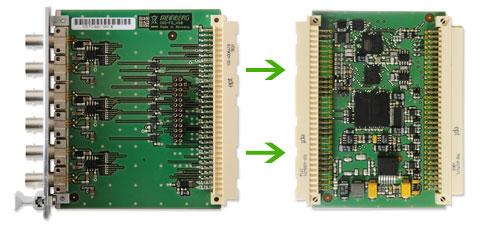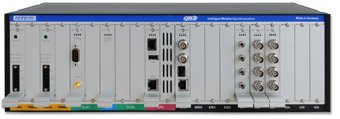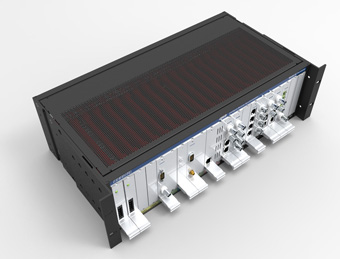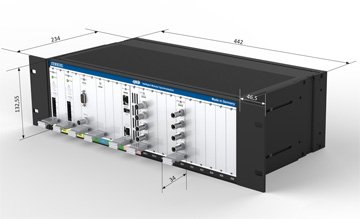LANTIME M3000S: Modular Time and Frequency Synchronization Platform
Key Features


- Synchronizes NTP-compatible clients with support for NTP, SNTP, and NTS - Network Time Security
- Optimized space usage
- Synchronization of NTP and SNTP compatible clients
- Web-based status and configuration interface and console-based graphical configuration utility
- IMS - Intelligent Modular System platform
- Up to 10 PTP (IEEE 1588-2008) modules
- Redundant power and receiver option (eg GPS / GLONASS combination)
- Hot Plug
- Arbitrary combinations of modules
- Meinberg's LANTIME time server is available with a variety of additional output options: IRIG Time Code, frequency synthesizer and programmable pulse outputs illustrate some of the many expansion options for your NTP server
- Up to 24 additional LAN ports
Product Description
Just like the M3000 standard model, the LANTIME M3000S supports the following slot types:-
IMS-CLK: Up to two reference clock modules (redundant mode)
-
IMS-SCU: Accepts an RSC module for redundant operation (two CLK modules installed) or an SPT module for a single CLK configuration
-
IMS-PSU:Up to four high efficiency redundant power supplies (AC and DC versions available)
-
IMS-CPU: Central processor module providing NTP / SNTP time synchronization as well as remote and local management and configuration interfaces
-
IMS-IO: A variety of output signals for all types of synchronization tasks:
electrical and optical pulses, frequencies, time codes and serial time messages as well as additional network interfaces for network synchronization (IEEE-1588, NTP, Synchronous Ethernet) and additional remote management capabilities
High-End NTP Network Time Server for your Network
With up to 25,000 NTP requests per second (depening on the installed CPU module), the system is able to provide time for hundreds and thousands of NTP clients. The LANTIME management CPU module supports the following protocols: NTP / SNTP (v2, v3, v4), HTTP (S), SSH, Telnet, SNMP (v1, v2, v3), FTP, SFTP, DHCP/DHCPv6. For each system, up to 99 logical network interfaces are available (99 IPv4 and 99 IPv6 addresses, each logical interface can be assigned to one VLAN ID). Enterprise-grade features such as IPv6/Dual Stack support, IEEE 802.1Q VLAN support, LACP/high availability bonding as well as DSCP and IEEE802.1p QoS/CoS traffic prioritization ensure that this product can be installed and operated in almost every critical environment: a financial data center; an electrical substation; an NGN telecommunication network; a digital broadcasting infrastructure; air traffic control systems and many many other environments.
Synchronization for 2G / 3G / 4G base stations and LTE Advanced networks.
The PTP implementation supports both ITU-T profiles, ITU-T G.8265.1 for frequency and ITU-T G.8275.1 for frequency and phase. This enables accurate frequency and phase synchronization over packet networks for all network elements that require synchronization, including 2G / 3G / 4G base stations as well as LTE Advanced networks.
Scalable Synchronization Solution
All modules are hot-pluggable and can be configured via a central web interface or a CLI. An almost endless number of combinations of input and output modules handles almost any synchronization task and allows the system to fit into many different roles. The field-upgradeable and therefore highly scalable and flexible IMS concept will grow with your demands. New technologies can be easily integrated into your existing devices as soon as a corresponding module is available, supporting a new connector, signal type or protocol. This protects your investments as it removes the requirement to replace existing devices or add complete new systems when your sync requirements change.
Flexible Synchronization References:
IMS-MRI:Standard reference input cards supporting a number of different input signals like 1PPS, 10MHz, IRIG DCLS, IRIG AM
IMS-ESI: Extended reference inputs for synchronization sources like E1/T1 framed and unframed signals
Both of these slot types can alternatively accept I/O cards and therefore can be used to add output modules or network interfaces, resulting in a maximum of 10 output modules per chassis in combination with the 6 I/O slots.
Due to the hot-plug capabilities of the IMS platform it is possible to add additional modules or replace modules with zero downtime and no negative impact on the system and its modules.
Power supply failures and a large number of additional synchronization related alarms can be communicated using several different protocols, for example mail/SMTP messages, SNMP traps, SYSLOG messages, or alarm relay cards.
IMS Modules

BPE and CPE Modules
Most standard output signals like pulses (1PPS, 1PPM, programmable pulses) and frequencies (10 MHz, 2048 kHz, frequency synthesizer 1 kHz-10 MHz) are provided by two versatile I/O cards named BPE and CPE. Both of these two modules have been designed to cover a wide range of interface and signal/protocol requirements. The BPE modules distribute the signals generated by the reference receiver via the internal backplane to the available physical connections of the board. The modules of the BPE-8000 series also feature an electronic switch which allows the configuration of the output signals via the LANTIME web interface. CPE modules feature a two-tier architecture with a back-end and front-end. The back-end is responsible for internally routing the IMS synchronization signals, provided by the reference clock via the internal backplane. The front-end autonomously generates a wide range of different signals by using an on-board microprocessor and makes a selection of these signals available via physical connectors.
An impressive number of specialized IMS modules covers other application requirements, for example E1/T1 framed/unframed synchronization signals with full SSM/BOC support or low phase noise 10 MHz sine wave frequency outputs. Additional network interfaces for NTP, PTP/IEEE 1588, SyncE and remote management access are available, too.
Characteristics
| Supported Reference Signals | The following reference sources can be used to synchronize the system:
|
| Frequency Outputs | Frequency Synthesizer for arbitrary frequencies between 0.125 Hz and 10 MHz, adjustable phase, output via external modules such as IMS-BPE modules |
| Accuracy of Pulse Outputs | < ±50ns (OCXO SQ, OCXO HQ, OCXO DHQ) |
| Network Interface |
Basic Chassis:
CPU-C05F1 1 x 10/100 MBit, RJ45 CPU-C15G2 1 x 100/1000BASE-T RJ45 1 x 1000BASE-T SFP Network Expansion - LNE Options: Up to 24 additional network interfaces (GbE Gigabit Support) with 10/100/1000 MBit RJ45 connector or 1000BASE-T SFP (Multimode / Singlemode). |
| Power Consumption | 50W (max. 100W) |
| Operating Voltage | Maximum power range: AD10: 90 - 265 V AC, 47-63 Hz / 90-250 V DC DC20: 20 - 60 V DC DC10: 10 - 36 V DC Redundant power supplies available |
| Form Factor | Rackmount 3U chassis for standard 19'' racks |
| CPU |
CPU-C15G2
|
| Operating System of the SBC | GNU/Linux 4.x |
| Network Protocols OSI Layer 4 (Transport Layer) | TCP, UDP |
| Network Protocols OSI Layer 7 (Application Layer) | Telnet, FTP, SSH (including SFTP, SCP), HTTP, HTTPS, syslog, SNMP |
| Internet Protocol (IP) | IPv4, IPv6 |
| Network Autoconfiguration Support | IPv4: Dynamic Host Configuration Protocol - DHCP (RFC 2131) IPv6: Dynamic Host Configuration Protocol - DHCPv6 (RFC 3315) and Autoconfiguration Networking - AUTOCONF (RFC 2462) |
| Network Time Protocol (NTP) | NTP v2 (RFC 1119), NTP v3 (RFC 1305), NTP v4 (RFC 5905)
SNTP v3 (RFC 1769), SNTP v4 (RFC 4330) MD5 / SHA-1 Authentication and Autokey Key Management |
| Network Time Security (NTS) | As of LTOS version 7.08, all Meinberg IMS LANTIME time servers offer full support for NTS (Network Time Security) in unicast client/server mode. |
| Parallel Redundancy Protocol (PRP) | PRP (IEC 62439-3) |
| Time Protocol (TIME) | Time Protocol (RFC 868) |
| IEC 61850 | Synchronization of IEC 61850-compliant devices using SNTP |
| Hypertext Transfer Protocol (HTTP) | HTTP/HTTPS (RC 2616) |
| Secure Shell (SSH) | SSH v1.3, SSH v1.5, SSH v2 (OpenSSH) |
| Telnet | Telnet (RFC 854-RFC 861) |
| Simple Network Management Protocol (SNMP) | SNMPv1 (RFC 1157), SNMPv2c (RFC 1901-1908), SNMP v3 (RFC 3411-3418) |
| Physical Dimensions | 483 mm x 133 mm x 234 mm (268 mm)* - width x height x depth
* The sizes in brackets take into account the connections and module handles. |
| Supported Temperature | Operational: 0 - 50 °C (32 - 122 °F)
Storage: -20 - 70 °C (-4 - 158 °F) |
| Supported Humidity | Max. 95 % (non condensing) at 40 °C (104 °F) |
| Contents of Shipment | The scope of delivery includes a CAB-CONSOLE-RJ45 cable for initial start of operation. |
| Technical Support | Meinberg offers free lifetime technical support via telephone or e-mail. |
| Warranty | Three-year warranty |
| Firmware Updates | Firmware is field-upgradeable, updates can be installed directly from the unit or via a remote network connection. Software updates are provided free of charge for the lifetime of your Meinberg product. |
| RoHS Status of Product | This product is fully RoHS-compliant. |
| WEEE Status of Product | This product is handled as a B2B (Business to Business) category product. To ensure that the product is disposed of in a WEEE-compliant fashion, it can be returned to the manufacturer. Any transportation expenses for returning this product (at end-of-life) must be covered by the end user, while Meinberg will bear the costs for the waste disposal itself. |
| Additional Information | Additional information about the Meinberg LANTIME family of NTP time servers and other LANTIME models can be found on the LANTIME overview page . |
Downloads
Data Sheet
Short Info Sheet
Manuals
- Handbuch (deutsch) ltos_7-10.pdf als PDF: 27763KB - Stand: 25.Sep.2025
- Handbuch (deutsch) ltos_7-08.pdf als PDF: 28311KB - Stand: 22.May.2025
- Handbuch (deutsch) m3000-s_base.pdf als PDF: 14441KB - Stand: 25.Jul.2024
- Handbuch (deutsch) setup-guide_s.pdf als PDF: 1117KB - Stand: 12.Jul.2023
- Manual (english) ltos_7-10.pdf as PDF: 25998KB - Rev.: 2025-Sep-25
- Manual (english) ltos_7-08.pdf as PDF: 26745KB - Rev.: 2025-May-22
- Manual (english) ltos_6-24.pdf as PDF: 17777KB - Rev.: 2022-Dec-01
- Manual (english) m3000-s_base.pdf as PDF: 13829KB - Rev.: 2024-Jul-25
- Manual (english) setup-guide_s.pdf as PDF: 1117KB - Rev.: 2023-Jul-12
MMS Server LANTIME PICS
-
MMS_Server_LANTIME_PICS
Protocol Implementation Conformance Statement for the IEC 61850 MMS Server in Meinberg IMS LANTIME Clock
(PDF: 178 KB - Rev.: 2024-Feb-03)
LTOS - CLI and REST API Reference
- For drivers, SDKs, tools and utilities, please check our Download Section






